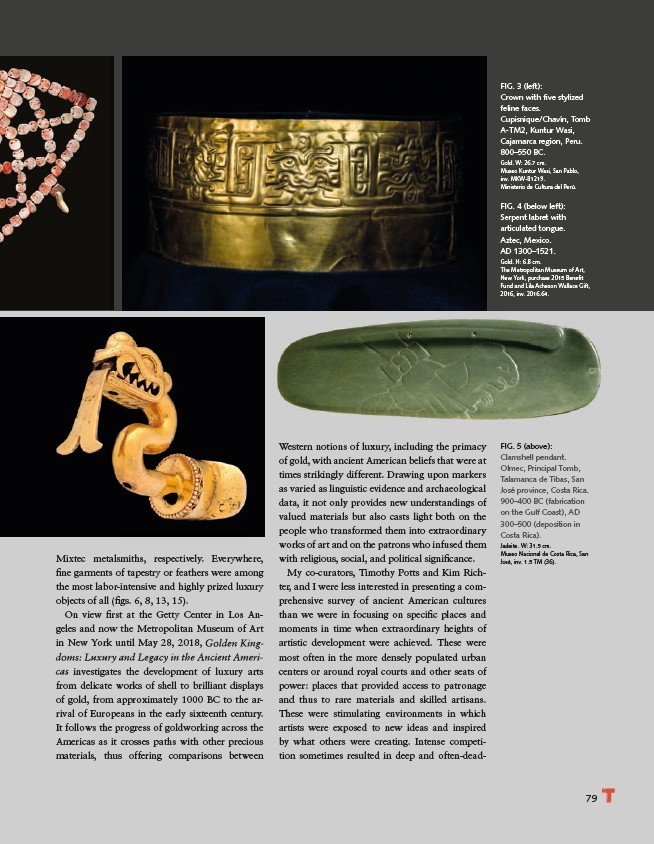
FIG. 3 (left):
Crown with five stylized
feline faces.
Cupisnique/Chavín, Tomb
A-TM2, Kuntur Wasi,
Cajamarca region, Peru.
800–550 BC.
Gold. W: 26.7 cm.
Museo Kuntur Wasi, San Pablo,
inv. MKW-81219.
Ministerio de Cultura del Perú.
FIG. 4 (below left):
Serpent labret with
articulated tongue.
Aztec, Mexico.
AD 1300–1521.
Gold. H: 6.8 cm.
The Metropolitan Museum of Art,
New York, purchase 2015 Benefit
Fund and Lila Acheson Wallace Gift,
2016, inv. 2016.64.
79
Mixtec metalsmiths, respectively. Everywhere,
fine garments of tapestry or feathers were among
the most labor-intensive and highly prized luxury
objects of all (figs. 6, 8, 13, 15).
On view first at the Getty Center in Los Angeles
and now the Metropolitan Museum of Art
in New York until May 28, 2018,
investigates the development of luxury arts
from delicate works of shell to brilliant displays
of gold, from approximately 1000 BC to the arrival
of Europeans in the early sixteenth century.
It follows the progress of goldworking across the
Americas as it crosses paths with other precious
materials, thus offering comparisons between
Western notions of luxury, including the primacy
of gold, with ancient American beliefs that were at
times strikingly different. Drawing upon markers
as varied as linguistic evidence and archaeological
data, it not only provides new understandings of
valued materials but also casts light both on the
people who transformed them into extraordinary
works of art and on the patrons who infused them
with religious, social, and political significance.
My co-curators, Timothy Potts and Kim Richter,
and I were less interested in presenting a comprehensive
survey of ancient American cultures
than we were in focusing on specific places and
moments in time when extraordinary heights of
artistic development were achieved. These were
most often in the more densely populated urban
centers or around royal courts and other seats of
power: places that provided access to patronage
and thus to rare materials and skilled artisans.
These were stimulating environments in which
artists were exposed to new ideas and inspired
by what others were creating. Intense competition
sometimes resulted in deep and often-dead-
FIG. 5 (above):
Clamshell pendant.
Olmec, Principal Tomb,
Talamanca de Tibas, San
José province, Costa Rica.
900–400 BC (fabrication
on the Gulf Coast), AD
300–500 (deposition in
Costa Rica).
Jadeite. W: 31.5 cm.
Museo Nacional de Costa Rica, San
José, inv. 1.5 TM (36).